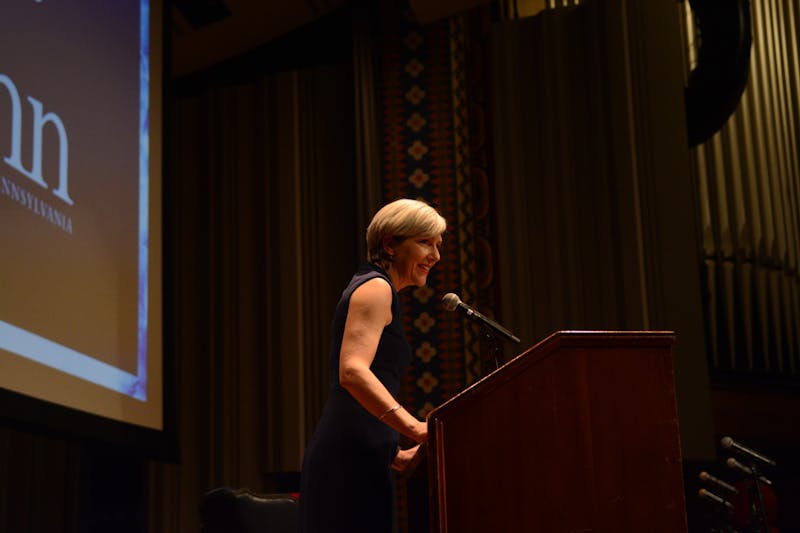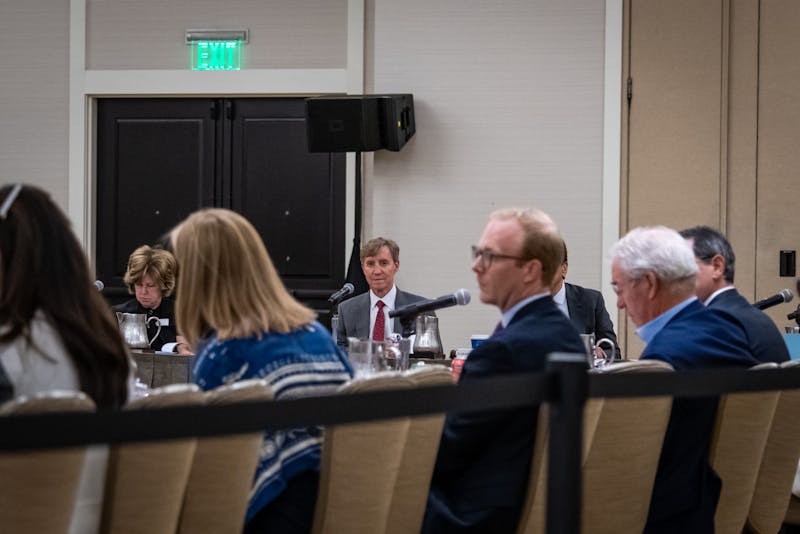Big 5 resurrection is cause for celebration To hear Philadelphia Mayor Ed Rendell speak at April 23's Palestra press conference announcing the sudden return of the full round robin to the legendary but disjointed Big Five, one could not help but wax nostalgic. But most Penn students have not gone through the aging process. On November 23, 1954, Penn President Gaylord Harnwell met with the presidents of La Salle, St. Joseph's, Temple and Villanova at Houston Hall to announce the official formation of the Big Five. Members of Penn's Class of 2002, however, know Harnwell only as a college house dorm and have never set foot inside the currently under-renovation Houston Hall. More importantly, the current crop of students has never seen a true Big Five champion crowned. Thousands of Penn students cheered the Quakers' march to the Ivy title and the NCAAs this past season. Those same fans scratched their heads while trying to figure out how the Red and Blue managed to defeat Temple, St. Joe's and La Salle yet still finish a second-place 1-1 in the puzzling Big Five standings. It's been eight years since a class graduated from Penn knowing what it means to see a complete slate of games played in the Big Five. For over 30 years, the Palestra served as the exclusive home of the Big Five as sell-out crowds routinely packed the most storied gymnasium in college basketball for Big Five doubleheaders and City Series matchups. In June 1986, the Big Five presidents signed a 10-year pact to continue the traditional full round robin format but with games played at each school's respective gymnasium. In May of 1991, Villanova, citing an increased Big East commitment, put an abrupt end to the 10-year deal by requesting a schedule reduction to just two City Series games each year. In April, the five schools revealed the surprising news that the full round robin schedule would be revived starting next season. Thanks to the Big East's reducing its number of conference games from 18 to 16 and the NCAA's raising the number of allowed regular-season games to 28, Villanova has leapt back into the fold and a real Philadelphia champ will once again be crowned. "I never expected that they would arrive at this -- it's a remarkable thing," Temple coach John Chaney said. "It's pretty darn good that we finally found some reconcilable differences to reach this level, because I think it's good for the city." On Friday, Big Five Executive Director and former Penn Athletic Director Paul Rubincam could hardly contain his enthusiasm. "It's exciting -- I woke up at three o'clock this morning and couldn't get back to sleep while thinking about the excitement for Philadelphia basketball," he said. Even Villanova, for eight years the source of the Big Five fans' anguish, got into the act. "I'm very proud to be a part of it," Villanova AD Tim Hofferth said. "It's a great day for college basketball." For eight years, the Big Five existed in name only. The champion crowned each year was just a paper champion, as fans at the four "city" schools cursed the suburban Wildcats, the two-game series and now-departed 'Nova coach Rollie Massimino, seen as the villain behind the Big Five's breakup. But while the true Big Five -- the reason why Rendell called Philadelphia "without question the capital of college basketball" -- lay dormant, a glimmer of what the Big Five had meant during its 30-plus-year heyday could be seen every time two of the member schools met on the hardwood. Any disbeliever need look no further than November 23, 1998, when the Quakers beat then-No. 6 Temple and thousands of screaming Penn students stormed the court in a basketball-induced fervor. These fans might not cringe at the mention of "90-47" and might not have heard of the legendary Ken Durett, but when they held their fingers in the air and screamed "We're No. 1!" they learned a little something about the meaning of the Big Five and bragging rights. Perhaps an even better example that the Big Five magic did not evaporate despite the City Series' loss of meaning is the Penn-St. Joe's contest of January 24, 1998. On a chilly Saturday night in West Philadelphia, a standing-room-only crowd packed the Palestra. Red-wigged Hawks fans screamed themselves hoarse. And when Paul Romanczuk went to the line with two seconds left and the Quakers down two, an entire section of Penn fans held its collective breath. Close to 9,000 spectators saw the Hawks steal a back-and-forth, down-to-the-wire battle that night. But this was not the Penn-Temple game of November 23, with the Owls holding a top-10 national ranking and the Quakers the co-favorite for the Ivy title and a possible-return to the top 25. This was a non-conference battle between two sub-.500 squads, each with an outside chance at best of reaching the NCAAs. And it was a sellout. While the Hawks-Quakers game that night might not have sent ESPN scurrying to rearrange its broadcast schedule, in terms of Philadelphia basketball it truly meant something. The beauty of the Big Five is that when two Philly teams take the court, rankings and won-loss records get tossed out the windows of the 71-year-old Palestra. The confusion of the muddled half-round-robin standings aside, Big Five games taken in isolation have remained exciting and intense. Just ask Penn AD Steve Bilsky. "I would come to the Big Five games, whether Penn was involved or not, and I didn't see any change in the way the players played the game, the competitive spirit, the coaches' intensity," he said. "The essence of the Big Five [was] still alive.? The players, the spirit and the competition has never left." And now, for the first time since 1991, those games have real meaning beyond the scope of their action-packed 20-minute halves -- a real Philadelphia champion will once again be crowned. It would be easy for a Penn fan to complain. At best, the Palestra will host six Big Five games; at worst, it will see just Penn's two home contests. And the fabled doubleheader at the Palestra, practically a religious event in the "capital of college basketball" for over 30 years, will remain a thing of the past. But to take a negative stance would mean being blinded by nostalgia. "In a totally ideal sense, to have all the games at the Palestra would be wonderful but -- especially in Temple's case of having a new facility -- it might not be totally fair across the board to have that be an edict," Bilsky said. "But I think enough of it is captured in the competition, in the fact that's there four games so there's going to be a championship. And I think that's the essence of it and that'll make it just as good as it's been." As a Penn student who has never seen a Big Five doubleheader, who has never seen a Villanova home game played at the Palestra, I could complain about missing out on the way things used to be, on a period in Philadelphia college basketball I can only imagine. But the essence of the Big Five lies in the games themselves. Even when there was no real title at stake, the excitement was still there. So when Temple AD Dave O'Brien says, "We know that the Palestra will be rocking again but we know that the other facilities in the city will be rocking as well. I guarantee you that the Apollo is going to be rocking too," my heart skips a beat. So next year, whether it's the Palestra or the Apollo, Tom Gola or the Pavilion, I'll be there. Because the important thing is that the Big Five is back. There will be a true champion once more. And it will be a great day for college basketball, Philadelphia and tradition.
The Daily Pennsylvanian is an independent, student-run newspaper. Please consider making a donation to support the coverage that shapes the University. Your generosity ensures a future of strong journalism at Penn.
DonatePlease note All comments are eligible for publication in The Daily Pennsylvanian.







